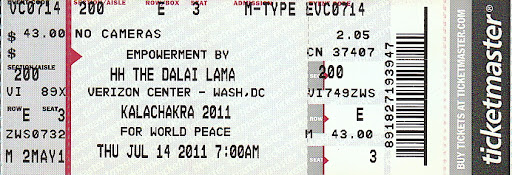
Prior to Empowerment, HH continued Teachings.
[What follows is my incomplete and probably incorrect interpretation]
On the Vajrayana approach to meditation
Common to all Tantra teachings is visualization. In order to invoke subtle mind, the grosser mind should cease. Meditation is a means to perceive ultimate reality and understand its emptiness (voidness). There is no difference between Sutra and Tantra as far as the nature of reality is concerned. The difference comes at the level of subjective experience: one meditates on imagining oneself in a form of a deity. This is only possible by invoking the subtle mind. This is very different from meditating on the nature, let's say, a flower. Even though the ultimate nature of reality (emptiness/clear-light on the external level) is the same, the objects of meditation in the Pali tradition (Theravada) and and in the Tantric tradition (Vajrayana) are different. Both meditate on the void/empty nature of reality but the methods they use differ significantly.
How is Kalachakra Tantra is different from other higher-level Tantras
In the higher-level Tantra there are father-tantra, mother-tantra, and non-dual tantra. Depending on classification, father- and mother-tantras are either considered a subset of non-dual tantra or the latter constitutes its own separate class. [One commentator] establishes correspondence between Kalachakra initiations (empowerments) and the classes of tantra: 2nd initiation relates to father-tantra; 3rd initiation, to mother-tantra; and 4th initiation, with non-dual tantra.
Kalachakra is referred to as explicit (or clear) Tantra, as opposed to obscure (or oblique) ones. The clarity refers to the 4th initiation: in the Kalachakra Tantra, the 4th empowerment is presented explicitly, while in others it is said that it is based on the 3rd, without further elaboration. In other Tantras there are references to rainbow or other subtle bodies but in the Kalachakra Tantra the approach is different: it uses the subtle energy, the clear light. Only in the Kalachakra Tantra the practice involves clear (subtle) Bodhicitta drops (red and white), and from the merge of the two and their dissolving comes the dissolution of the temporal body.
We can distinguish two kinds of emptiness:
- without aspect, and
- with aspect (empty form).
- based on the sexual energy;
- mutable (changeable) — via imagining interaction with wisdom, and
- immutable — great seal of empty form.
In other higher-level Tantra practices there are similar practices but what is specific to Kalachakra is that the clear light itself is being used, as oppose to the grosser level of mind.
On the Dzogchen approach
In the Dzogchen approach, using clear mind does not require that the grosser mind ceased its activity. This is an advanced technique, based on fundamental awareness. This is not an easy approach, and practicing it is only possible with a highly qualified Dzogchen teacher/guru.
On authenticity of Vajrayana and Kalachakra
HH then returned to the topic of authenticity of Tantrayana he had partially addressed on Monday, July 11 (Day 6). There are all kinds of questions about Tantric tradition in general and Kalachakra Tantra in particular: Kalachakra is a later text, it could not possibly emanate from the Buddha, where, exactly, Shambala was located, etc. The point, however, is not to take the text literally. Other Buddhist texts mention “pure land” or “copper mountain,” but these are not being interpreted literally. Historical analysis is not a criterion of veracity of teaching. Even in the Sutras the metaphorical interpretation is often required.
Some Indian and Tibetan masters did question the authenticity and validity of Kalachakra Tantra. However, they did so after having themselves practiced the Kalachakra Tantra and having had visualizations based on it.
The Sakya approach speaks of the following sequence:
authentic scriptures --> tradition --> experience.
In practice, the sequence is often the opposite:
experience --> tradition --> authentic scriptures
There are ordinary experiences and extraordinary experiences. In the Tantric (esoteric) tradition you do have extraordinary experiences. You have to trust your teacher, and through your personal experience develop admiration for the great masters of the past. HH reminisced about his conversation, when he was still in Tibet, with a Chinese communist official about whether there is reincarnation. The official said there was not but he admitted he could no prove that. Absence of evidence is not the evidence of absence, so in some circumstances one cannot rely only on reason and needs to have a belief, a conviction. HH then relayed a story about a Kagyu lama who spent time in a Chinese prison and then came to India and participated in the Kalachakra initiation. During empowerment he had a vision of all the masters of his lineage being in one room. There was no reason for that lama to tell untruth, he had nothing to gain. Extraordinary experiences are possible.
HH then said that he has students who gained a great level of insight as a result of Kalachakra empowerment and surpassed himself (“The son is greater than the father,” as an old Tibetan saying goes.)
Ultimately though, one needs to familiarize oneself with different Tantric systems and judge for oneself how effective the Kalachakra Tantra is based on the personal experience.
Evening dharma talk: Robert Thurman
Professor Thurman gave a great talk. He is an engaging speaker with encyclopedic knowledge and volcanic temperament. However, he put forth so much politics that it turned me off, somewhat—even though I agree wholeheartedly with most of what he said. Temperamentally, I feel more comfortable with Dr. Berzin.
No comments:
Post a Comment